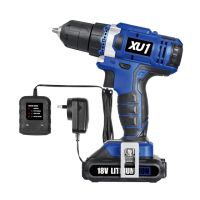Charger and battery pack
safety instructions
Drill Driver Safety
Warnings
This tools charger is double insulated; therefore
no earth wire is required.
2
1. Before using the charger read all instructions and
cautionary markings on the charger, battery pack
and the product using the battery pack.
2. This charger is not intended for any uses other
than charging rechargeable batteries. Any other
use may result in risk of re, electric shock or
electrocution.
3. Do not place any object on top of the charger or
place the charger on a soft surface that may result
in excessive internal heat. Place the charger in a
position away from any heat source.
4. To reduce risk of damage to the electric plug and
cord, pull by the plug rather than the cord when
disconnecting the charger.
5. Make sure the cord is located so that it will not be
stepped on, tripped over, or otherwise subjected to
damage or stress.
6. An extension cord should not be used unless
absolutely necessary. Use of an improper extension
cord could result in the risk of re, electric shock or
electrocution.
7. Do not operate the charger if it has received a
sharp blow, been dropped or otherwise damaged
in any way. Have it checked by an electrician or
power tool repairer.
8. Do not disassemble charger. Take it to an electri-
cian or power tool repairer when service or repair is
required. Incorrect reassembly may result in a risk
of electric shock, electrocution or re.
9. To reduce risk of electric shock, unplug the charger
from the outlet before attempting any cleaning.
Removing the battery pack will not reduce this risk.
10. Never attempt to connect 2 chargers together.
11. DO NOT store or use the tool and battery pack in loca-
tions where the temperature may reach or exceed
40ºC (such as inside sheds or metal buildings in
summer).
12. The charger is designed to operate on standard
household electrical power (240 volts). Do not
attempt to use it on any other voltage!
13. The battery pack is not fully charged out of the
carton. First read the safety instructions and then
follow the charging notes and procedures.
14. The longest life and best performance can be
obtained if the battery pack is charged when the air
temperature is between 18 - 24ºC. Do not charge
the battery pack in an air temperature below 10ºC
or above 40ºC. This is important and will prevent
damage to the battery pack.
15. Do not incinerate the battery pack even if it is
seriously damaged or is completely worn out. The
battery can explode in a re.
16. Never attempt to open the battery pack for any rea-
son. If the plastic housing of the battery pack breaks
or cracks, immediately discontinue use and do not
recharge.
17. During charging, the battery must be placed in a
well ventilated area.
WARNING! Wear ear protectors when
impact drilling Exposure to noise can cause
hearing loss.
Use auxiliary handle(s), if supplied with
the tool. Loss of control can cause personal injury.
Hold power tool by insulated gripping
surfaces, when performing an operation
where the cutting accessory may contact
hidden wiring or its own cord. Cutting
accessory contacting a “live” wire may make exposed
metal parts of the power tool “live” and could give the
operator an electric shock.
Before drilling into walls, ceilings etc, ensure that there
are no concealed power cables or pipes in the cavity.
WARNING! Some dust created by
power sanding, sawing, grinding,
drilling and other construction
activities contain chemicals known to
cause cancer, birth defects or other
reproductive harm. Some examples of
these chemicals are:
• Lead from lead-based paints
• Crystalline silica from bricks and cement and other
masonry products
• Arsenic and chromium from chemically treated timber
Your risk from exposure to these chemicals varies,
depending on how often you do this type of work. To
reduce your exposure to these chemicals: work in a
well ventilated area and work with approved safety
equipment, such as dust masks that are specially
designed to lter out microscopic particles.
This appliance is not intended for use by
young or inrm persons unless supervised by
a responsible person to ensure that they can use the
appliance safely. Young children should be supervised
to ensure that they do not play with the appliance.

